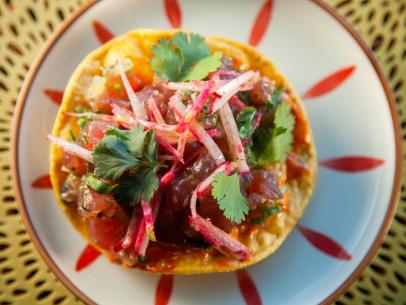Spicy Tuna with Crispy Rice
- Level: Easy
- Total: 3 hr 20 min (includes standing and chilling times)
- Active: 45 min
- Yield: 8 servings
-
- Nutritional Analysis
- Per Serving
- Serving Size
- 1 of 8 servings
- Calories
- 494
- Total Fat
- 30 g
- Saturated Fat
- 3 g
- Carbohydrates
- 43 g
- Dietary Fiber
- 2 g
- Sugar
- 5 g
- Protein
- 14 g
- Cholesterol
- 18 mg
- Sodium
- 419 mg
- Level: Easy
- Total: 3 hr 20 min (includes standing and chilling times)
- Active: 45 min
- Yield: 8 servings
-
- Nutritional Analysis
- Per Serving
- Serving Size
- 1 of 8 servings
- Calories
- 494
- Total Fat
- 30 g
- Saturated Fat
- 3 g
- Carbohydrates
- 43 g
- Dietary Fiber
- 2 g
- Sugar
- 5 g
- Protein
- 14 g
- Cholesterol
- 18 mg
- Sodium
- 419 mg
Ingredients
Sushi Rice:
Spicy Tuna:
Directions
- For the sushi rice: Rinse the rice in a large bowl under cold running water, gently agitating it with your hands to remove extra starch, until the water runs clear, about 5 minutes. Drain the rice in a fine-mesh strainer.
- Line an 8-inch square baking pan with parchment, leaving a 2-inch overhang on 2 sides. Set aside.
- To use a rice cooker: Add the rice and 1 1/3 cups water to a rice cooker and gently move it from side to side to evenly settle the rice. Cook on the white rice/sushi rice setting according to the manufacturer's instructions.
- To cook on the stovetop: Add the rice and 1 1/2 cups water to a medium pot. Gently move the pot from side to side to evenly settle the rice. Bring to a boil over high heat, then top with a piece of aluminum foil and then the lid to create a tight seal. Reduce the heat to low and steam for 25 minutes; do not open the lid. Remove the rice from the heat and let it sit, covered, for 10 minutes more.
- Meanwhile, combine the vinegar, sugar and 1 teaspoon salt in a small saucepan. Bring to a simmer over medium-low heat, stirring frequently, until the mixture is just steaming and the sugar is dissolved (do not boil), about 2 minutes.
- Transfer the rice to a large bowl and immediately sprinkle the vinegar mixture evenly over the hot rice (see Cook’s Note). Using a rice paddle or spatula, gently cut the vinegar mixture into the rice and alternately fold the rice so the mixture doesn’t pool on the bottom of the bowl. Make sure the mixture is evenly distributed throughout the rice. Spoon the rice into the prepared pan and use wet hands (so the rice doesn’t stick to them) to press the rice so it's tightly packed and even. Refrigerate until chilled, at least 2 hours and up to 24 hours. If chilling for longer than 2 hours, cover with plastic wrap.
- Line a baking sheet with paper towels; set aside. Use the parchment overhang to lift and transfer the rice block to a cutting board. Cut the rice into 16 squares.
- Add the vegetable oil to a large skillet and heat over medium heat until shimmering. Working in 2 batches, add 8 rice squares to the oil and cook, untouched, until the bottom of the rice is a deep golden brown, 6 to 8 minutes. Use a metal spatula to flip the rice and continue to cook until the other side is golden brown, 4 to 5 minutes more. Remove to the prepared baking sheet and repeat with the remaining rice squares.
- For the spicy tuna: Whisk the mayonnaise, sesame oil, soy sauce, ginger, sriracha, scallions and the juice of 3 lime halves in a medium bowl until smooth. Fold in the tuna until just coated.
- Spoon 2 heaping teaspoons of the tuna mixture on top of each rice cake. Top the tuna with avocado slices and a serrano slice. Squeeze the juice of the remaining lime half over top and serve immediately.
Cook’s Note
It’s important to add the vinegar mixture to the rice as soon as it's finished cooking. If the rice sits too long, it will be difficult to season evenly. The bites should be assembled just before serving, but you can make the rice up to 1 day in advance. You can chop the tuna ahead of time and keep it chilled, but don't toss it in the sauce until the last minute or the acid in the sauce will start to change the texture. Depending on your altitude or climate, you may want to adjust the amount of water or rice when cooking sushi rice. If it's really dry, increase the water a little bit (or decrease if humid). If high altitude typically affects your cooking, add a little more rice (about 1/4 cup).
Looking for Something Else?
Related Pages
- Chunky Guacamole With Serrano Peppers Recipe
- Grilled Tuna Burgers with Spicy Mayo Recipe
- Spicy Tuna Sashimi Recipe
- Tuna Sushi Burrito Recipe
- Marinated Seared Tuna, Crispy Vegetables,...
- Finocchio Tuna with Crispy Vegetables and Gilroy...
- Grilled Halibut with Crispy Rice and Green Beans...
- Speedy Spicy Tuna Bowls Recipe
- Spicy Tuna and Watermelon Poke Recipe


































